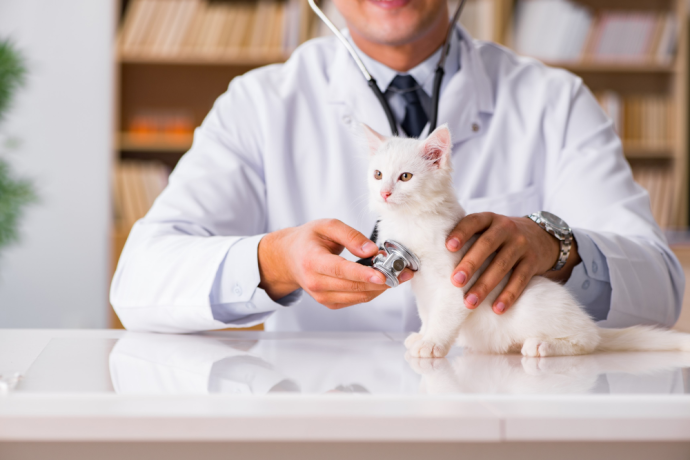Ear Mites in Cats: Signs and Treatments
Written by:
Author: Dr. Edele Grey
Dr. Edele Grey is a veterinary surgeon with seven years of experience. She professionally works mostly with horses but has treated pets of all sizes including terrapins, llamas, and others. Dr. Grey graduated with honors from the University College Dublin, Ireland, has completed further education in Equine Sports Medicine. In her free time, she enjoys writing about pet ownership and educating people about veterinary care of animals and preventing disease.
View all 10 articlesLearn about our editorial process and veterinary review board.
Viewed: 324
Updated on: 03/26/2021
Ear mites are one of the common causes of earache for our feline fur-friends. These crawling mites live on the skin in your cat’s ear canal and feed off naturally produced skin oils and ear wax. Otodectes cynotis, to give them their scientific name, are microscopic parasites that can’t jump or fly – but they can crawl into a kitty’s ear (and dogs’ ears too) and rapidly set up home. Outdoor cats tend to be more commonly affected by ear mites than indoor kitties. These little critters cause inflammation, pain, and swelling inside your cat’s ears while causing intense itchiness and can even cause long-term or permanent damage to your kitty’s ears if untreated.
How do I tell if my Cat has ear mites?
So, if these little bugs are microscopic, how can you tell that your cat has ear mites? There are some typical signs that you can see, including your pet having an almost constant urge to scratch their ears or shake their head as though something is stuck inside. Affected kitties tend to hold their ears back flat against their head, and you may see a dark, smelly discharge on the inside of your cat’s ear pinna (the part covered by fur). The discharge can be gunky but is usually quite dry and may look like coffee grounds. This is digested blood in the mites’ poop.
Diagnosis can only be confirmed by your veterinarian as these signs can also be seen with bacterial or fungal ear infections, and ear mite treatments won’t help in these cases. Your vet will examine your pet’s ears with a special magnifying light source (otoscope) to look down into the canals. Sometimes, the mites may be visible as tiny white dots. If your cat’s ear is too painful, your vet will look at a sample of the discharge and wax under a microscope to confirm an infestation.
How can I get rid of ear mites in my Cat?
The first step in treating an ear mite infestation is to thoroughly clean the debris and discharge. This gunk protects the mites from topical medications, and they actually thrive inside it. This also allows the irritated skin to heal after being cleaned and exposed to the air. If your kitty has a significant infestation or a secondary bacterial infection, you may receive anti-inflammatory/pain medication and antibiotics to treat that and keep your cat comfortable.
READ MORE: Best Cat Shampoo
Cat Ear Mites medicine
Spot-on/Single Treatments
There are a number of “spot-on” treatments that kill ear mites. This is often the easiest way to treat a skittish outdoor kitty. A thorough ear cleaning is still required to remove the build-up of wax, but luckily your vet will do this during the consultation. Some of these products are applied to the skin between your kitty’s shoulder blades or even into the ear canal directly. These products usually require 2 applications (about a month apart) to eliminate the infestation by killing any adults that were eggs at the first treatment. Products applied to the skin often target multiple parasites, including fleas, and are absorbed into the skin where it is distributed throughout the skin. If you use a product like this that kills ear mites, it will prevent re-infestation while also protecting against other nasty bugs like fleas and some worms.
Ear drops
There are also a number of ear drop treatments available, most of these need a minimum of 3 weeks application because they only target adults and it takes 21 days for eggs to fully mature into adult mites. These treatments must be used as prescribed by your veterinarian, and for the length of time required. If you don’t, then the infestation will just return once the drops are stopped, and there is a risk of the mites developing resistance to the medication which will reduce its efficacy in the future. Some of these products are available over-the-counter or in pet stores, but not many cats cooperate with drop application for 3 weeks.
There are some topical drops available in recent years that contain a medication that kills eggs and adult mites, so these may only need to be used for up to 14 days. Most of these products also include antibiotics for treating secondary infections, while some also contain an anti-inflammatory medication to soothe the pain and redness. Some of these products also include lubricants that clean the debris.
Injections
The use of ivermectin injections is not currently approved by the FDA for use in small animals.
Natural remedies
There are some home remedies that may work for ear mites but your vet should always confirm the diagnosis before you institute any of these treatments as they may exacerbate infections or allergies if mites aren’t the root cause of your pet’s ear issues. There are lots of sites advising using olive oil or almond oil drops in your cat’s ears. Don’t use bitter almond oil, it’s toxic to cats! If you prefer to try a natural remedy for your kitty’s ear mite problem, then confirm a product with your vet first to ensure it’s safe and won’t make the problem worse. One treatment you can try (after consulting your vet) is to apply a few drops of baby oil 3-4 times per day for about 30 days in order to smother the mites. These treatments are intensive as they don’t affect the mites’ eggs and you need to treat until those have all matured into adults too.
READ MORE: Cat eye injuries
How long will it take to get rid of ear mites in my Cat?
Now you’ve started treatment, how long do you need to wait before your kitty is mite free? To figure this out, we need to understand the weird life cycle of ear mites. The adult female lays 5 eggs per day, all of which hatch after a short incubation period, just 4 days. The newly hatched larvae feast on your kitty’s ear wax and skin oils for about 7 days before molting into the next stage, called a protonymph which then molts into a deutonymph about a week later. The deutonymph then mates with an adult male mite.
Seems fairly standard for a parasite, right? Well, here comes the unusual bit – at this point, the deutonymph hasn’t actually developed a gender. After mating, the deutonymph then molts into either a male or female. This speeds up the process of producing the next generation if the nymph becomes female because it’s full of fertile eggs ready to produce the next generation. Adult ear mites live roughly two months, all of it on your pet, though these mites can survive for short periods of time in the environment.
With a 2-month life span and an approximate 21-day life cycle, it will take some time to eliminate all mites from your pet once you’ve started treatment. As mentioned before, many products only target adults, and thus treatment must last at least 21-days to ensure that all emerging adults are also killed. Single-dose treatments should be re-applied at the appropriate intervals to achieve the same results. Repeating these treatments will also prevent the re-infestation of your pet with ear mites, especially if your cat loves being outside with others.
As the ear mites can only survive a short time in the environment, a thorough vacuum and laundering of pet bedding are often sufficient to clean the home. You should also speak with your vet about treating any other pets in the home as ear mites affect other pets too and travel between hosts in close quarters, especially with co-grooming in kitties.
What if my Cat’s ears don’t improve after treatment?
Sometimes it can feel like nothing you’ve tried has worked for your kitty’s ear problems but there is some troubleshooting you can do to figure out why this may be. While the dark discharge can be pretty characteristic of ear mites, was this diagnosis confirmed by your veterinarian? Some bacterial or fungal infections can produce similar discharges or can develop as a secondary complication of ear mites.
Was the course of treatment completed? It’s tempting to stop applying drops (especially if you have an ornery kitty) once the signs resolve, but this doesn’t mean the ear mites have been eliminated, and you may see a return of them within days. Occasionally, the irritation of your pet’s ear remains because there are chunks of hard wax inside that needs to be cleaned out to give your pet comfort.
If all other pets in your home weren’t treated, it may be that your cat has picked up another infestation from one of them. If all of these have been confirmed, your vet may advise changing products. Always consult your vet and never use a product designed or prescribed for another pet as it may be toxic to your kitty.
READ MORE: How to tell if my Cat is Sick
Can humans or other pets in the house get ear mites from Cats?
Humans can’t become infested in the same way our pets are by these creepy critters, but ear mites can bite us and cause a rash, so prompt treatment, hygiene, and prevention are key. This is especially important if there are vulnerable people in the household; e.g. elderly, immuno-compromised, or very young children.
Otodectes cynotis (the culprit) can set up homes in other animal species including dogs, rabbits, and ferrets. Close contact is usually required but co-habiting can be enough to transmit infestation in many cases, hence treatment of the whole fur-family is often advised.
Can ear mites cause other problems?
Parasites are, unfortunately, parе for the course in pet companionship. It’s our responsibility to prevent and promptly treat any diseases our kitties may pick up. Ear mites are one of these bugs, and alongside their irritating presence, they can actually cause long-term consequences for your cat.
Ear mites are very irritating to kitties, and they will scratch incessantly which will traumatize the skin, causing bleeding and more pain and inflammation. These wounds can become infected, or your kitty may develop a swollen, red, and painful ear pinna due to an aural hematoma. These hematomas are accumulations of blood between the skin and cartilage of the ear due to the breaking open of blood vessels and can lead to an abscess forming. Surgery may be needed to treat an aural hematoma, and your kitty may be left with some cosmetic changes.
An infestation with ear mites increases the risk of your cat developing a bacterial or fungal ear infection and thus a build-up of pus. These infections and irritation can lead to a torn eardrum, which is very painful for your cat and allows an infection to travel deeper into your pet’s ear. Deeper infections can have your kitty display some very upsetting signs, including falling to one side, having a head tilt, or walking in circles. If both of your pet’s ears are infected, then they may seem to act ‘drunk’ and fall over a lot. While affected by these infections, your cat won’t be able to hear in the affected ear, and without prompt treatment, this can become permanent.
READ MORE: What vaccines do indoor Cats need yearly
Conclusion
Ear mites are annoying pests that cause pain and irritation to our feline friends, but luckily they are relatively easy to treat these days. You should always have your veterinarian diagnose any ear problems in your kitty as there are a number of conditions that present with similar signs, and treatment for the wrong illness could make it worse.
 Cat Veterinary Tips Cat Motion Sickness: How to Deal With Motion Sickness in Cats?
Cat Veterinary Tips Cat Motion Sickness: How to Deal With Motion Sickness in Cats? - 728
- 0
 Cat Veterinary Tips Signs That Your Cat is in Labor: How to tell if a Cat is Pregnant?
Cat Veterinary Tips Signs That Your Cat is in Labor: How to tell if a Cat is Pregnant? - 14225
- 1
 Cat Care Why Does My Cat Attack My Legs? 10 Reasons Why and What To Do About It (Vet-Approved Advice)
Cat Care Why Does My Cat Attack My Legs? 10 Reasons Why and What To Do About It (Vet-Approved Advice) - 45566
- 21
 Cat Veterinary Tips Cat Stomach Gurgling: Vet Advice on Why is Your Cat Stomach Gurgling?
Cat Veterinary Tips Cat Stomach Gurgling: Vet Advice on Why is Your Cat Stomach Gurgling? - 35339
- 4
 Cat Veterinary Tips My Cat Lost its Voice: Can Cats get Laryngitis? (Vet Advice)
Cat Veterinary Tips My Cat Lost its Voice: Can Cats get Laryngitis? (Vet Advice) - 23247
- 13























